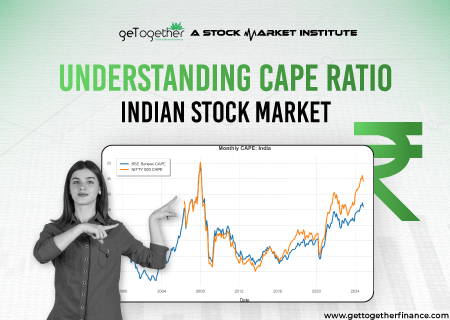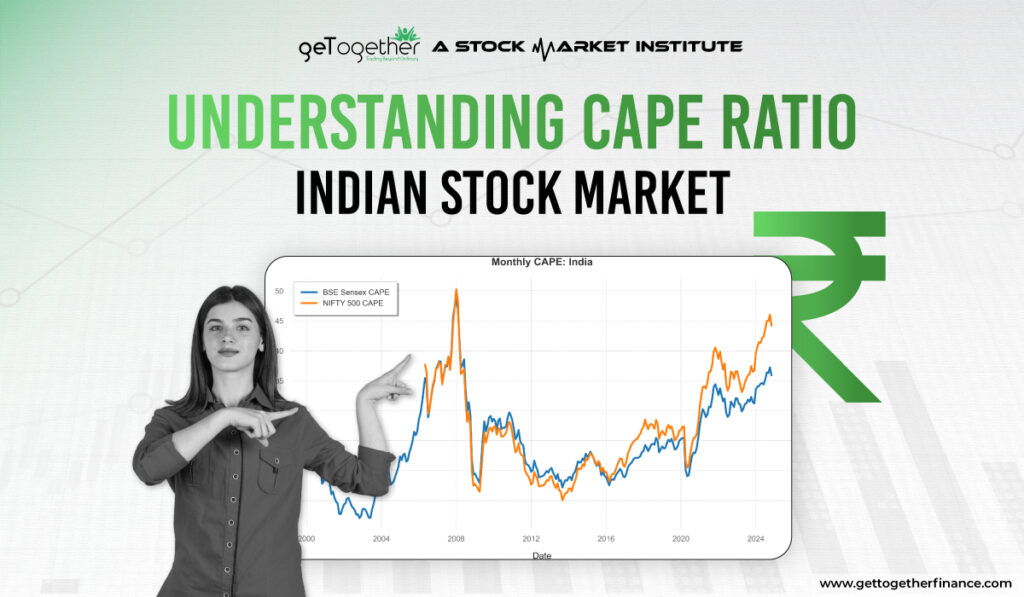Understanding CAPE Ratio: Indian Stock Market
- November 22, 2024
- 714 Views
- by Manaswi Agarwal


As an investor, you must be facing a dilemma about ascertaining exact undervaluation and overvaluation of stocks. To determine the true value of the stock and to make informed investment decisions, several valuation metrics have enlightened the issue concluding it positively. The article will look in depth into one of the valuation metrics i.e. CAPE ratio to help investors identify exact valuation of the stock with growth potential in future.
What is the CAPE Ratio?

Being an investor, you are required to monitor the stock market regularly and be familiar with the financial ratios that provide a view of the market’s valuation over time. CAPE ratio was developed by Nobel laureate Robert Shiller. This valuation metric helps anticipate the future market returns. CAPE ratio which stands for Cyclically Adjusted Price to Earnings ratio is a valuation measure that adjusts for inflation and averages earnings over a ten year period.
Investors can gain insights about market conditions for a long term perspective on market valuations. The primary aim of calculating this ratio is to assess the overvaluation or undervaluation of stocks by comparing its current share price to inflation adjusted average earnings over the past 10 years.
How Does the CAPE Ratio works?

Rober Shiller derived CAPE Ratio as another version of price to earnings ratio to help investors analyze the market and identify whether the stock is overvalued or not. It is usually applied to broad equity indexes to ascertain index valuation.
In the case of CAPE ratio, it works by taking out the average of last ten years earnings of the company and adjusting them for inflation which are then divided by the current index prices by that adjusted earnings. A company with a lower CAPE ratio suggests higher returns for investors over time.
Formula:
CAPE ratio = Price / Average Earnings for 10 years adjusted according to inflation
(Average Inflation – Adjusted Earnings)
Example
Let say as an investor, you want to invest in a company ‘A’ with its current stock price as Rs 100 with average earnings over the past 10 years per share as Rs 10 realizing the value as 10. This is then compared to the current levels of the index market. If the ratio realized is lower, then it suggests that the stock price is overvalued.
Why is CAPE Ratio important for Investors?

The overvaluation and undervaluation of a stock indicates stock price movements in future and the purpose of this ratio is to analyze the valuation of stock index for investors to make informed investment decisions. A low CAPE ratio indicates undervaluation of the stock which makes it a buying opportunity for investors. The median value of a CAPE ratio is 16 as proven historically, 10 or less than 10 indicates good future performance, and greater than 25 might indicate a future crash.
Also Read: Price to Free Cash Flow Ratio
Limitations of CAPE Ratio

There are several criticisms one of which is that it highly depends on historical data instead of focusing on future returns. The ratio majorly concerns the past records and the market changes occurring in the near future are not considered which limits its capability as a fundamental ration to predict future market moves.
Complex Calculation
Since the ratio considers the last 10 years of earnings to ascertain the valuation which can be complex and subject to interpretation which results in affecting accuracy of the measure of valuation.
Ignores Market Condition
The ratio does not count the fluctuating market conditions to analyze interest rates or monetary policies that influence market valuations. Moreover, it does not consider other important factors like company debt levels or economic growth to assess market valuation.
Misinterpretation of Short Term Movement
CAPE ratio is not a stable method to identify short term movements as it predicts the valuation of a stock based on indices. This affects the price movements in the long term which is why it does not prove to be efficient for swing traders or positional traders.
Cut Short
Determining the valuation of index guides investors to make informed investment decisions in the stock market and CAPE is one fundamental valuation metric that calculates inflation and averages earnings over a ten year period for an investor. However, the measure is not reliable because of the complexities and does not assure guarantee. Approaching technical analysis, using the demand and supply approach is one of the most reliable methods for investment.
FAQs
What is a CAPE Ratio?
CAPE ratio also known as cyclically adjusted price earnings ratio is used to measure stock market valuation to realize whether a stock is overvalued or undervalued.
What does a CAPE ratio indicate?
A high CAPE ratio signifies that the stocks are expensive relative to their earnings whereas a low cape ratio indicates that they are cheap. However, it is not a perfect measure of calculation for valuation.
Is CAPE ratio a perfect measure of valuation?
CAPE ratio is one beneficial metric to analyze the overvaluation or undervaluation of a stock by ascertaining its past earnings but is not the perfect measure of calculation as it does not predict the future stock market performance.



 Instagram
Instagram 
